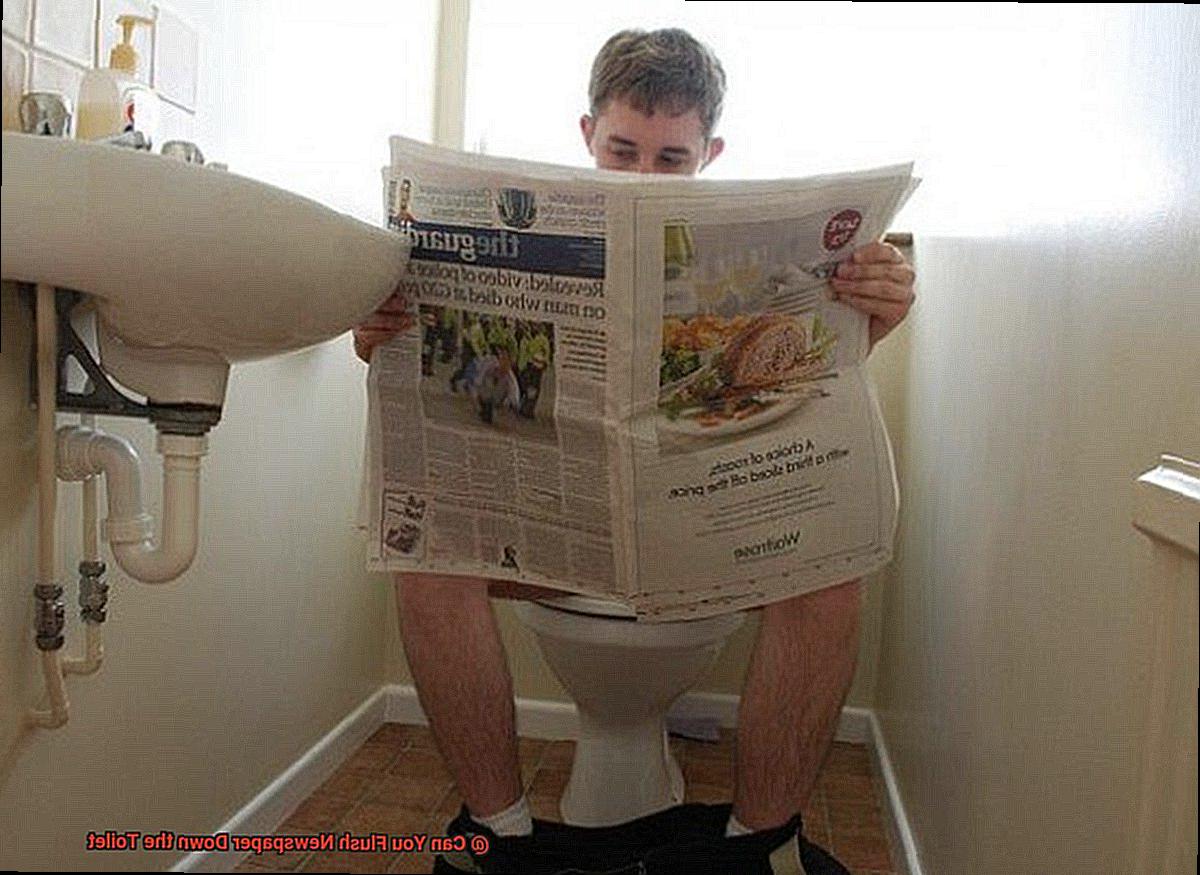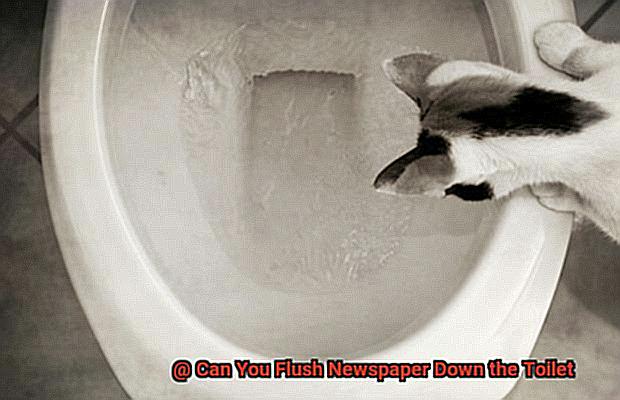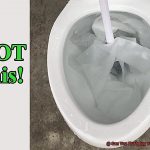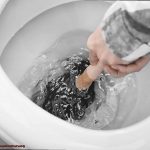Have you ever found yourself in a desperate situation where you reached for the nearest paper product to use as toilet paper? Maybe it was a roll of paper towels or even worse, a crumpled up newspaper. But can you really flush newspaper down the toilet like regular TP?
Despite what some may think, flushing newspaper down the toilet is not a harmless act. In fact, it can cause serious problems for your plumbing system and the environment. So, before you decide to use that old newspaper as a last resort, let’s dive into why it’s not such a good idea.
In this blog post, we’ll explore whether flushing newspaper down the toilet is safe or not. We’ll also take a closer look at the potential issues that can arise from doing so. Spoiler alert: your pipes and septic tank won’t be too happy about it.
Toilet plumbing systems are designed to handle only human waste and toilet paper – anything else can cause clogs and damage. And while newspaper is technically biodegradable, it can take quite some time to break down in water, potentially causing harm to our environment.
So let’s avoid any unnecessary plumbing mishaps and environmental damage by learning more about this topic together. Stick around as we investigate whether or not flushing newspaper down the toilet is truly worth the risk.
Contents [show]
Reasons to Avoid Flushing Newspaper Down the Toilet
Clogging Your Pipes with Newspaper: A Costly Mistake
Flushing newspaper down the toilet may seem like a convenient way to dispose of it, but it can quickly turn into a costly mistake. Unlike toilet paper, newspaper is not designed to break down easily in water. Instead, it can clump together and create blockages in your pipes, leading to damage to your plumbing system and even your home. Don’t let this happen to you. Save yourself the hassle and expense by disposing of newspaper properly in a recycling bin or trash can.

The Harmful Effects of Newspaper Ink on the Environment
Did you know that the ink used in newspapers can contain harmful chemicals? Flushing newspaper down the toilet can cause these chemicals to leach into the water supply, polluting waterways and harming aquatic life. In addition, if the newspaper ends up in a landfill, the ink may release toxins into the air. Do your part in protecting the environment by properly disposing of newspaper in a recycling bin or trash can.
The Health Risks of Flushing Non-Toilet Paper Products
Flushing non-toilet paper products down the toilet can lead to sewage backups and overflows, exposing you and your family to harmful bacteria and viruses. These backups can also create a health hazard and costly cleanup. Avoid this risk by following city and municipal ordinances against flushing anything other than human waste and toilet paper down the toilet.
Avoiding Fines and Penalties by Properly Disposing of Newspaper
Did you know that some cities and municipalities have ordinances against flushing non-toilet paper products down the toilet? Violating these ordinances can lead to financial consequences, including fines and penalties. Protect yourself by properly disposing of newspaper in a recycling bin or trash can.
Protecting Our Planet by Properly Disposing of Newspaper
Proper disposal of newspaper is not only important for avoiding plumbing problems and penalties, but it’s also essential for protecting the environment. By disposing of newspaper properly in a recycling bin or trash can, you’re doing your part in reducing pollution and preserving natural resources. Let’s work together to keep our pipes clean and our planet healthy.
Risk of Blockages
While toilet paper is specifically designed to dissolve in water and pass through plumbing systems with ease, other paper products pose a significant risk of blockages.
Take newspaper, for instance. Made from a different type of paper than toilet paper, newspaper does not break down as easily or quickly in water. This makes it a prime candidate for getting caught in pipes and causing serious blockages that can be both time-consuming and expensive to fix.
Even small pieces of newspaper flushed down the toilet can add up over time and increase the risk of blockages. That’s why it’s best to dispose of newspaper in the garbage rather than flushing it down the toilet. By doing so, you can help prevent unnecessary plumbing issues and keep your bathroom running smoothly.
It’s important to remember that flushing paper products other than toilet paper can not only lead to plumbing issues but also have negative impacts on our planet. Improperly disposed of paper products can harm aquatic life and expose you to harmful bacteria and viruses. To protect our environment and keep our pipes clean, always dispose of these products properly in a recycling bin or trash can.
Harmful to the Environment
Not only can it cause potential blockages in your plumbing system, but it can also have a significant and harmful impact on our planet.
Let’s take a closer look at the treatment process of wastewater. When flushed, wastewater goes to a treatment plant where it undergoes a series of processes to remove pollutants and contaminants before being released back into the environment. However, if non-biodegradable materials like newspaper are flushed, they cannot be broken down during this process and end up accumulating in the treatment plant. This can lead to clogging and damage to machinery, making it more difficult and costly to treat water effectively.
The harmful effects of flushing newspaper do not stop there. If it makes its way into bodies of water such as rivers and oceans, it can be incredibly damaging to wildlife. Fish and turtles may mistake it for food, leading to potential health issues and even death. The ink used in newspapers can also contain harmful chemicals that can leach into the water and harm aquatic life.
It’s critical to remember that every small action we take has an impact on our environment. Properly disposing of non-biodegradable materials like newspaper is essential for protecting our planet and its inhabitants from unnecessary harm. Instead of flushing them down the toilet, consider recycling or disposing of them in the trash.
Alternatives to Flushing Newspaper Down the Toilet
Fortunately, there are several alternatives available that can help reduce your environmental impact and even provide opportunities for creativity and innovation.
The first alternative to consider is simply disposing of your old newspapers in the trash. While this may seem like the most straightforward option, it’s important to note that newspapers can take years to decompose in landfills. That’s why it’s essential to consider other options as well.
One such option is using your newspapers for composting. Adding shredded or torn pieces of newspaper to your compost pile can provide valuable carbon-rich material that helps balance out the nitrogen-rich materials like food scraps and yard waste. Just ensure that the newspaper is in small pieces to allow for proper breakdown.
If you’re feeling artistic, you may want to repurpose your old newspapers for arts and crafts projects. From paper mache sculptures to decoupage crafts, there are countless ways to turn your old newspapers into something fun and innovative.
Lastly, if you’re committed to reducing your environmental impact, you can switch to reusable toilet paper made from soft, absorbent materials like bamboo or cotton. These products can be washed and reused multiple times, reducing waste and saving money over time.
Safety Tips for Flushing Other Items Down the Toilet
It’s time to stop. Flushing non-flushable items down the toilet can cause significant damage to your plumbing system and even harm the environment. Here are five safety tips for flushing other items down the toilet that you need to know.
Wave goodbye to newspaper down the toilet. Newspaper is not designed to dissolve quickly in water and can create blockages in your pipes. This can lead to costly plumbing repairs and even damage to your home. Remember, newspaper belongs in the recycling bin, not in the toilet.
Avoid flushing feminine hygiene products down the toilet. These products are not biodegradable and can cause blockages in your plumbing system. It’s best to dispose of them in a trash can. Plus, it’s more discreet.
Resist the temptation to flush baby wipes down the toilet. Even though some wipes may claim to be “flushable,” they can still cause clogs in your plumbing system. Do yourself a favor and dispose of them in a trash can. Your plumbing system will thank you.
Never flush medications down the toilet. Medications can contaminate water sources and harm aquatic life. Instead, check with your local pharmacy or waste disposal facility for proper disposal methods. Proper medication disposal is crucial for protecting our environment.
Don’t even think about flushing food waste down the toilet. Food waste can clog pipes and cause unpleasant odors in your plumbing system. Plus, it’s just plain gross. Composting or disposing of food waste in the trash is a much better option.
In conclusion, remember that toilets are designed to handle only human waste and toilet paper. Flushing other items can cause serious plumbing problems and environmental issues. By following these safety tips, you can avoid costly repairs and help protect the environment.
How to Unclog a Blocked Toilet
With a few easy and effective methods, you can unclog your toilet in no time and save yourself from unnecessary expenses. So let’s dive in and explore the steps to unclog a blocked toilet.
Assess the Blockage
Before you start anything, assess the severity of the blockage. If the water level in the toilet bowl is rising and close to overflowing, it’s important to act fast. Grab a bucket and remove some of the water before proceeding.
Plunge It Out
One of the most common methods is using a plunger. Make sure you have a good quality plunger with a rubber suction cup that fits snugly over the toilet drain. Create a good seal around the drain and use a vigorous up-and-down motion to create suction and push the blockage through the pipes. Repeat this motion several times until the blockage clears.
Snake It Away
If the plunger doesn’t work, you can try using a toilet auger or snake. This is a long flexible cable with a corkscrew end that can break up and remove obstructions in the pipes. Insert the end of the snake into the drain and turn the handle clockwise while pushing it further in. When you feel resistance, turn the handle counterclockwise while pushing and pulling back and forth until you feel the blockage break up.
Chemical Drain Cleaner
Another option is to use a chemical drain cleaner. However, be careful when using these products as they can be harsh and potentially damage your plumbing system. Always follow the instructions carefully and wear protective gear such as gloves and goggles. Pour the recommended amount of cleaner into the toilet bowl and let it sit for several hours or overnight. Flush with hot water to see if the blockage has cleared.
When to Call in a Pro
If none of these methods work, it is best to call in a professional plumber to avoid causing further damage or creating a bigger problem. They have specialized tools and equipment that can effectively clear even the most stubborn of blockages.
Prevention is Key
As the old saying goes, prevention is better than cure. Avoid flushing anything down the toilet that is not intended for that purpose, such as paper towels or feminine products. By practicing good toilet habits, you can prevent future clogs and save yourself from unnecessary hassle and expenses.
In conclusion, unclogging a blocked toilet doesn’t have to be a daunting task. With these easy and effective methods, you can clear your toilet blockage and get back to your daily routine in no time. Remember to assess the severity of the blockage, plunge it out or snake it away, use chemical drain cleaners sparingly, and call in a pro if needed.
Plumbing Services for More Serious Blockages
With their experience and tools, they can quickly identify and fix the problem, saving you time, money, and stress in the long run.
Plumbers use different methods to address more serious blockages. Plumbing snakes are flexible rods that can be inserted into pipes to break up and remove blockages of various sizes. These snakes come in different sizes and types, depending on the severity of the blockage and the size of the pipes. However, for more challenging blockages, hydro jetting is an effective option. Using high-pressure water, this method can blast away any obstructions in the pipes, clearing even the most stubborn blockages.
While these methods may come at a higher cost than DIY solutions, they’re necessary for more serious blockages that could cause further damage if left untreated. A professional plumber can give you peace of mind knowing that the problem has been fixed correctly and won’t happen again anytime soon.
yRgugtE2vXA” >
Conclusion
To sum up, the convenience of flushing newspaper down the toilet is not worth the potential plumbing nightmares and environmental damage it can cause. Newspaper fibers are not designed to break down quickly in water, leading to clogs that can be a hassle and costly to fix. Moreover, the ink used in newspapers contains harmful chemicals that can contaminate our waterways and harm aquatic life.
To avoid such issues, make sure to dispose of your newspaper in recycling bins or trash cans. If you do encounter a blocked toilet, don’t panic. There are several easy and effective methods you can try at home, such as plunging or snaking. However, for more severe blockages, it’s best to call in a professional plumber who has specialized tools and equipment.
Remember, prevention is always better than cure when it comes to clogged toilets. Avoid flushing anything other than human waste and toilet paper down the toilet. By practicing responsible waste disposal habits, we can all contribute to a cleaner and healthier planet.






